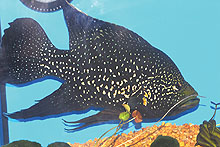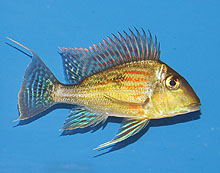WHAT'S NEW ACROSS THE WORLD
Select date in side bar to go to a What's New of previous issues
| What's New
©by Laif DeMason
Interest in various cichlids in America and across the world continues with a noticeable uptick over the first half of 2017. Curiously, as I sell to importers in several countries, many hobbyists across the world seem to have the same interests in the same groups of cichlids. I put it down to presentations on various social media and internet videos. Many groups of Tanganyika cichlids still command top demand whereas new interests in predatory Malawi haplochromines and various mbuna (especially OB types) are a close second. Consequently several wannabes have joined the import/export game. Remember, you get what you pay for!
Here’s “what’s new” on the cichlid scene: |
Lake Tanganyika
Many people have asked me where has all the availability gone for small bred Tropheus types lately? Remember the extensive Brichard compound in Burundi closed down last year and they produced thousands of Tropheus commercially each month. This shortage vacuum will take time to fill.
| WHAT'S NEW: LAKE TANGANYIKA |

You asked for Xenos? Well okay, after a slow start the flood gates for Xenotilapia have just opened! X. spilopterus, papilio, and flavipinnis from different locations are in. Pictured here, the X. flavipinnis from Sibwesa, Tanzania, sporting their rich orange-yellow dorsal fin margin. Photo by A. Konings.
|

You asked for Cyprichromis? Exporters from Tanzania and Zambia happily worked out the logistics and they are available in earnest! All types and species and locations are in demand including leptosoma, sp. ‘leptosoma jumbo', and microlepidotus. Pictured here, the C. sp. ‘leptosoma jumbo’ from Chimba, Zambia with its turquoise fins and yellow throat. Photo by A. Konings.
|

The Tropheus imported as “Kachese” seems to be quite variable depending on its exact collection point. If it is caught to the east, then it’s more yellow like T. moorii “Golden Kazumbe”; more to the west then its more red and called “Red Kachese”. Here the classic variety of Tropheus Kachese with the lower cheek fleck and orangey body coloration.
|

Goby cichlids from Tanganyika also enjoy a strong following from some dedicated hobbyists. Eretmodus types are especially sought after since there is a large variation in colors at different locations around the lake. Here a “yellow bar” type of Eretmodus from Sibwesa, Tanzania, with a strong red dorsal fin margin and reddish bar coloration.
|
Lake Malawi
Big news from Lake Malawi! Mozambique divers have been permitted and started collecting again along their “forgotten” coast. Yes, some of the classics such as Metriaclima estherae from Minos Reef and also new types have been exported. Let us hope that the logistics will improve and the Malawi hobbyists will be willing to receive and pay for these rarities!

Many of the new Mozambique imports are species labeled from “Mtengula (=Metangula), Mozambique” without much other information. Here pictured the recently arrived Aulonocara stuartgranti “Red Flush Mtengula”, with no more of a specific collection location. Similar fish are also collected along the eastern Malawi coast as well.
|

Many species of predatory haplochromines from Lake Malawi are in high demand. Especially sought after are the varieties that grow to a very large size and that then have striking colors. Pictured here is an exquisite male breeder Tyrannochromis nigriventer originally from Makonde, Tanzania.
|

Copadichromis parvus, exported as Copadichromis Melas Mtengula, is certainly a new fish from a location somewhere between Chiloelo and Metangula in Mozambique. This fish resembles a white blaze C. sp. ‘kawanga borleyi’ more than a ‘mloto’ type.
|

One of the interesting fish that was recently imported is Cynotilapia zebroides (afra) from Minos Reef, Mozambique, which is colored similar to the Cobwé variety. Wild specimens for this fish haven’t been exported for two decades! Photo by A. Konings.
|
Madagascar & Neotropicals
WHAT'S NEW:
MADAGASCAR & NEOTROPICALS |

Most all the Paratilapia species are popular with those who like LARGE cichlids regardless whether they are really P. polleni or P. bleekeri. Many of the large-spot types, such as P. sp. ‘andapa’ or P. sp. ‘green spot’, are sold as bleekeri regardless. Pictured here a male P. ‘bleekeri’ green spot which can have spots that are mostly blue-green or yellow.
|

Often sold in the past as Geophagus surinamensis along with dozens of other closely related eartheaters, G. sveni hails from the Rio Tocantins, Brazil, and has made its debut in the hobby in earnest lately. This somewhat large fish is best kept in groups of 8 to 10 individuals to keep them feeling secure. Photo by A. Konings.
|
Select date in side bar to go a What's New of previous issues |









